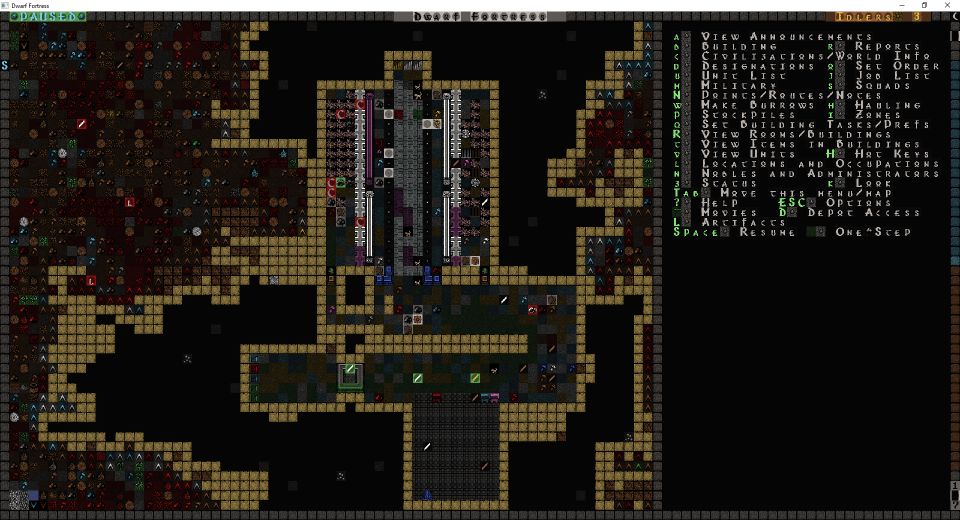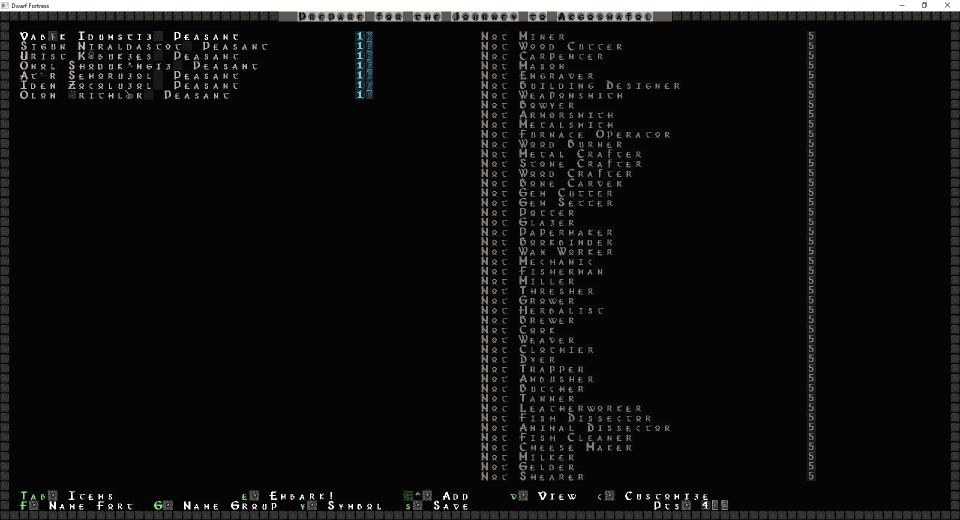Written by Liberty, edited by Otaku Apologist
Dwarf Fortress, made by bay12games, is one of the most complex simulation games in existence. At its surface, it’s about managing a group of dwarves building a fortress. But no description can encompass the sheer depth of the game and the countless, countless things which can go horribly wrong. Expect a lot of pointless death and destruction as monsters and enemy civilizations besiege you.
You can download this game at the official website for Dwarf Fortress.
STORY
You are Armok, the god of blood. You create and destroy universes at your own whim. You have made countless worlds and populated them with gods, peoples, demons, werebeasts and other entities, then erased them once they displeased you. You are badass.
Apart from the premise, there is no set story in Dwarf Fortress. When you start up the game, you generate a world from scratch. You choose from a variety of different parameters for your world, set a specific amount of time you want to pass, then let the simulation begin! No two worlds are the same. They all have their own history, continents, mountains, civilizations, gods, kings, and titans, all randomly generated. The story comes from the interaction of all these various beings and forces within the world. Even your own dwarves have their own history, their own preferences, their own fears, skills and families. No two stories are the same, and as you play the game, so too does your own story unfold. After your world is finished generating, you can either play Fortress Mode or Adventure Mode. For this review, I will be looking at Fortress Mode, which is all about building your own fortress. Adventure Mode is a roguelike mode where you control a single adventurer. I haven’t played Adventure Mode in much depth yet, but expect a review in the future.

GAMEPLAY
In Fortress Mode, you control a group of dwarven settlers as they establish a mighty fortress. There are dozens of different jobs and occupations that your dwarves can take up. There’s beekeeping, farming, poetry, your dwarves can be millers, pressers, and more. There is no particular goal or approach you have to take with this game, so you can have an entire fortress of beekeepers if you want – or necromancers, or vampires, or werebeasts!
One of the core mechanics of Fortress Mode is the needs of your dwarves. As they work and meander around your fortress, they’re going to react to different things they encounter. For example, drinking alcohol makes a dwarf very happy. Eating in a dining hall makes them happy. If you want things to run smoothly in your fortress, you have to meet the needs of your dwarves as best as you can. Give them books to read, create plenty of chairs and tables for them to enjoy their meals, give them a tavern where they can sing and perform.
If you fail to provide for their needs, you’ll get to watch your fortress spiral into chaos. Your dwarves will be throwing tantrums, going insane and berserking. One version of insanity involves the dwarf throwing off all its clothes and running around the fortress babbling, until it dies of hunger or dehydration. It’s all about doing what you can to make your dwarves happy. But there will be times where nothing you do can make one of your poor citizens cheerful, and you will have to deal with them in another way.

Another core mechanic of the game is mining. You will be using this skill more than any other. Mining allows you to carve out rooms, collect ore and once you dig deep enough, you can reach the cavern layers. The caverns are an entire ecosystem which are independent of the surface and have a variety of different resources which can’t be found anywhere else, ranging from special types of tree, to spider silk, to elk birds and gigantic pools of magma. But beware, delving too deep can be dangerous…
While you’re trying to stop your fortress from collapsing into complete anarchy, the world around you is changing. Nearby civilizations grow, expand their territory, battle one another, and accumulate wealth. They will interact with your civilization in various ways. Dwarves, humans, and elves, will send out trade caravans to your fortress. These caravans are one of the most important things in the game, as they can provide you goods which you can’t access in your own fortress. Depending on who you trade with, you can also get unique goods. Elves can trade you rare beasts such as unicorns. Goblins, being the evil bastards they are, only send out raids and child snatchers to your fortress.

GRAPHICS
Dwarf Fortress uses ASIII graphics, which is as primitive as it gets. You can install graphics packs to make the game more pleasing to the eye, but Dwarf Fortress will never have impressive graphics. But neither is it a game you play for the eye candy.
SOUND EFFECTS AND VOICE ACTING (SFX)
Dwarf Fortress has barely any sound and no voice acting.
MUSIC
The soundtrack is composed on a single guitar by the game’s creator, Toady. It goes from intense to quiet and melodic. It somehow feels like it doesn’t fit the atmosphere, while at the same time fitting at the same time. In a world full of violent monsters, ravening undead, werebeasts and more intangible evils, this quiet track will be playing in the background.
There are a grand total of two music tracks in the entire game, and they will loop endlessly as you play. Apart from that, the only places where you will hear sound are in the introduction movie and the main menu. Dwarf Fortress, in my opinion, is best played muted with something else on in the background, like the Song of Durin from Lord of the Rings!
CONCLUDING WORDS
Few games in existence can surpass Dwarf Fortress in mechanical complexity. It’s a very unique experience. My review hasn’t covered even a fraction of what the game has to offer. While the interface is highly obtuse and there is an insanely steep learning curve, it rewards you for every little scrap of knowledge you accumulate.
I highly recommended this simulation game! Start playing Dwarf Fortress.
Overall
-
Graphics
-
Gameplay
-
Story
-
Music
-
SFX





